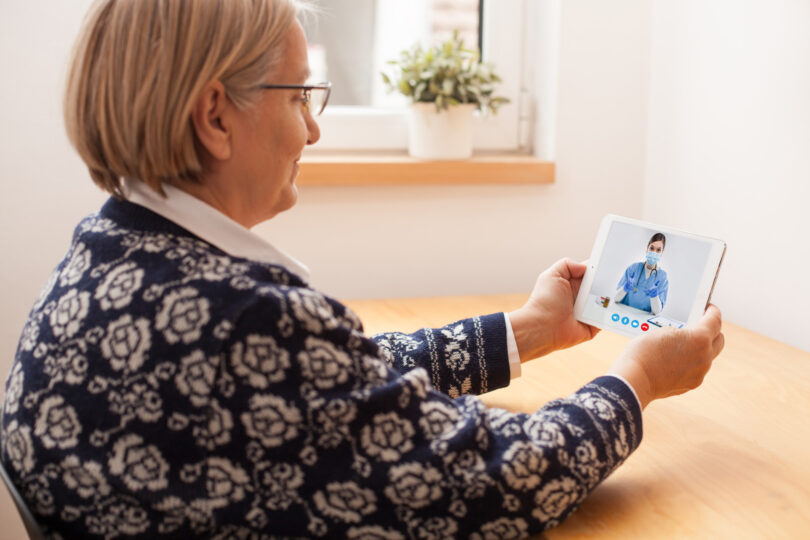Experts say resource is not only convenient, it can also make care more accessible
Ever since it was ushered into widespread use during the pandemic, virtual healthcare has become a much more common tool — including for virtual urgent care.
Sunnybrook Health Sciences Centre partners with University Health Network (UHN) to provide Toronto’s Virtual Emergency Department.
The service offers same-day appointments seven days a week for adult Torontonians with an urgent medical concern that is not life threatening (e.g. body aches, rash, nausea), and who are unable to make an appointment with a family doctor or nurse practitioner.
At Sunnybrook, roughly 6,000 patients have been seen through the virtual urgent care program since it began in December 2020. Most express appreciation for the convenience, privacy, and flexibility it offers.
“Virtual emerg is a great idea…It’s convenient, efficient and it’s working well. Thank you for seeing patients in virtual ER!” – Patient
For patients from equity-deserving groups – i.e. communities that face barriers to opportunities, resources, or services such as healthcare – virtual urgent care is seen to provide additional benefits.
At the latest Sunnybrook Speaker Series, Dr. Sander L. Hitzig, Program Research Director and Senior Scientist at the St. John’s Rehab Research Program at the Sunnybrook Research Institute, spoke about why that is the case.
“The number one benefit of virtual urgent care is that people from equity-deserving populations feel more control over their care experiences,” he said. “They feel safer in terms of their physical and mental health compared to past in-person encounters where they felt prejudiced against.”
Examples of underserved or equity-deserving populations include people who are low-income, people with disabilities, refugees, Indigenous or racialized persons, or members of 2SLGBTQIA+ communities.
Dr. Hitzig, whose research often evaluates new technologies and models of care, began examining the use and impact of Sunnybrook’s virtual urgent care program shortly after it was launched, in partnership with Dr. Justin Hall, Emergency Department physician and Program Lead of the Virtual Emergency Department.
Initial data suggested people from equity-deserving populations faced barriers accessing the service, such as not having reliable Internet access or a private space for their online appointment. Low digital literacy or English fluency were also common barriers.
Drs. Hitzig and Hall, and their colleagues, decided to dig deeper to learn more. Together with Access Alliance, a multicultural health and community services partner, they designed a qualitative study with the goal of better understanding how virtual urgent care met the physical, emotional, and social care needs of equity-deserving patient populations.
The researchers interviewed patients over the age of 18 who self-identified as belonging to equity-deserving groups. Many identified aspects of virtual care that could be improved – such as technical requirements that could be challenging for people with a learning disability.
But most of the patients who were interviewed also had favourable things to say about the service.
“One of the things that came out loud and clear was that people really welcomed the convenience and flexibility of virtual urgent care,” Dr. Hitzig said. “And they appreciated not having to wait a long time to be seen.”
The option to avoid a long wait in a crowded emergency department was especially appealing to people with chronic illnesses who might be immuno-compromised, Dr. Hitzig added.
Some patients who were interviewed also noted the financial benefits of virtual urgent care, such as not having to pay for transportation or parking.
Many also liked the focus and attention they received from staff during virtual appointments and the professionalism of the care providers, Dr. Hitzig said.
He added that several patients said they preferred virtual urgent care to past experiences at physical emergency departments when they had felt belittled or discriminated against.
“There is more work that needs to be done to better understand how virtual models of care can be better tailored to people from equity-deserving populations,” Dr. Hitzig said. “But overall, it is seen as a compassionate tool that is making healthcare more accessible.”
Asked what makes him most excited about the future of virtual urgent care, Dr. Hitzig said it is the sense of empowerment that patients described after accessing the service.
“Having more options to give people greater control over how and when they access healthcare is important because we want to be partners with the patients we are treating,” he said.
“If people have more positive experiences, that will lead to better outcomes for the patient and the healthcare system.”








